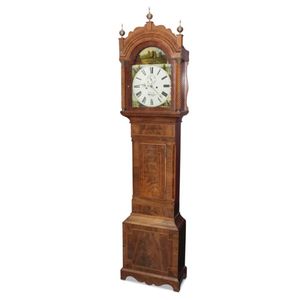Victorian Grandfather Clock with Painted Scenes and Spheres
You must be a subscriber, and be logged in to view price and dealer details.
Subscribe Now to view actual auction price for this item
When you subscribe, you have the option of setting the currency in which to display prices to $Au, $US, $NZ or Stg.
- Hood - In longcase clocks, the hood is the wooden case that surrounds the works and dial, and includes the glass front, which is usually hinged, so the door can be opened to wind the clock or adjust the time. In 18th and 19th century longcase clocks the hood usually slides forward for removal, allowing access to the works.
- Victorian Period - The Victorian period of furniture and decorative arts design covers the reign of Queen Victoria from 1837 to 1901. There was not one dominant style of furniture in the Victorian period. Designers used and modified many historical styles such as Gothic, Tudor, Elizabethan, English Rococo, Neoclassical and others, although use of some styles, such as English Rococo and Gothic tended to dominate the furniture manufacture of the period.
The Victorian period was preceded by the Regency and William IV periods, and followed by the Edwardian period, named for Edward VII (1841 ? 1910) who was King of the United Kingdom and the British Dominions and Emperor of India for the brief period from 1901 until his death in 1910. - Subsidiary Dial - On a clock or watch, a subsidiary dial, also called an auxiliary dial, is a dial that is secondary to the main dial and may show seconds, day of the week or month, or strike silent. A subsidiary dial may be within our outside the main dial, and a clock or watch may have several subsidiary dials.
This item has been included into following indexes:
Visually similar items

Antique pine elevated bookcase, with enclosed bookcase above 2 drawers and a 2 door cabinet, 106 cm wide, 47 cm deep, 235 cm high

Pair of Chinese Republic (1912-1949) ivory figures, depicting temple lions, male and female, each seated on a plinth and baring their teeth, he with paw on a ball, she with paw on a cub, both signed to base, 19 cm high. Ex: Private collection Sydney

Two 9ct gold-silver-lined Slave bangles. (2)

Emu egg carved silver plated desk comprising two carved eggs, the carving in the shape of the map of Australia with further third level carving of a kangaroo & kookaburra to one & an emu & lyrebird to the other, with applied an applied figure of a kangaroo
